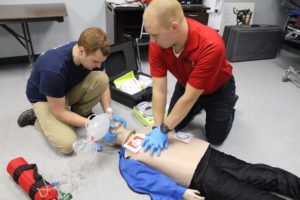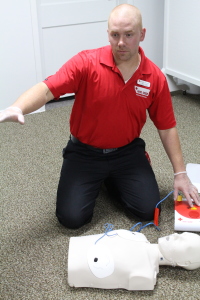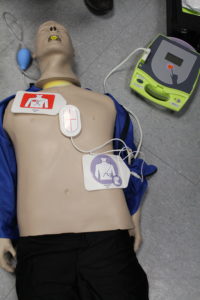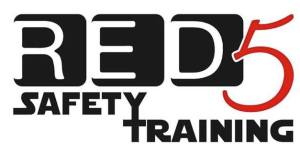Click on the button for the Course you want to know more about.
First Aid – CPR – AED
CPR/AED Emergency First AidStandard First AidBlended Learning
Online Courses
WHMIS TDG Fire Safety Lock-Out/Tag-Out
Professional Responder Courses
Basic Life SupportFirst ResponderEmergency Medical Responder
CPR/AED
Courses on cardiopulmonary resuscitation (CPR) provide the skills needed to recognize and respond to cardiovascular emergencies and choking for adults, children, and babies depending on the level of CPR chosen. All include training in the use of an automated external defibrillator (AED). Courses offer training suitable for workplace or general interest and includes the latest CPR guidelines.
Topics Covered Include:
- Preparing to Respond

- Understanding the Emergency Medical Services System
- Check Call Care – Scene Set-up
- Recovery Position
- Airway Emergencies
- Respiratory and Circulation Emergencies
- Assistance with Medications
- Angina and Heart Attack
- Stroke
- CPR
- AED – Automated External Defibrillator
The Different Levels:
Level A– Includes care for adults only.
Level C – Includes care for adults, children, and infants.
Course Duration: 4-6 Hours
Completion Requirements: 100% Attendance and 75% min. passing grade on written exam
Certification: 3 year Certification
Take-Home: Certification Card, Mini First Aid Kit.
Recertification:
Yes, with valid CPR Certificate. Recertification has the same duration and course requirements, and results in a certification card valid for another 3 years. NOTE: You may only recertify once on a valid certificate. You may not recertify a Recertification Card.
Emergency First Aid and CPR/AED
Basic one-day course offering an overview of first aid and cardiopulmonary resuscitation (CPR) skills for the workplace or home. Includes the latest first aid and CPR guidelines. Meets OHS regulations for Basic First Aid. Exceeds competitors’ standards by including injury prevention content, CPR and AED.
Topics Covered Include:
- Preparing to Respond

- Understanding the Emergency Medical Services System
- Check Call Care – Scene Set-up
- Recovery Position
- Airway Emergencies
- Respiratory and Circulation Emergencies
- Assistance with Medications
- Angina and Heart Attack
- Stroke
- CPR
- AED – Automated External Defibrillator
- Wound Care
- Intro to Head and Spine Injuries
- Fainting, Diabetic Emergencies, Seizures
Course Duration: 8 Hours
Completion Requirements: 100% Attendance and 75% min. passing grade on written exam
Certification: 3 year Certification
Take-Home: Certification Card, Mini First Aid Kit.
Recertification:
No. To keep this certification valid, you must redo the Emergency First Aid and CPR course every 3 years.
Standard First Aid and CPR/AED
Comprehensive two-day course offering first aid and cardiopulmonary resuscitation (CPR) skills for those who need training due to work requirements or who want more knowledge to respond to emergencies at home. Includes the latest first aid and CPR guidelines. Meets federal and a variety of provincial/territorial regulations for Standard First Aid and CPR. Exceeds competitors’ standards by including injury prevention content, CPR and AED to Levels C or HCP.
Topics Covered Include:
- Preparing to Respond

- Understanding the Emergency Medical Services System
- Check Call Care – Scene Set-up
- Recovery Position
- Airway Emergencies
- Respiratory and Circulation Emergencies
- Assistance with Medications
- Angina and Heart Attack
- Stroke
- CPR
- AED – Automated External Defibrillator
- Wound Care
- Head and Spine Injuries
- Bone, Muscle, and Joint Injuries
- Fainting, Diabetic Emergencies, Seizures
- Environmental Emergencies
- Poisons
Course Duration: 16 Hours
Completion Requirements: 100% Attendance and 75% min. passing grade on written exam
Certification: 3 year Certification
Take-Home: Certification Card, Mini First Aid Kit.
Recertification:
Yes, with valid SFA/CPR Card. Recertification has a shorter duration at just 8 hours, yet completion requirements remain the same. Successful participants receive a certification card valid for another 3 years. NOTE: You may only recertify once on a valid certificate. You may not recertify a Recertification Card.
Blended Learning
This is a new way to achieve valid and recognized certification. This new delivery method combines an online portion and an in-class portion that saves both time and money. All of the same topics are covered, with zero compromise to standards or quality. The advantage is gained when the participant is allowed to complete the theory aspect at their own pace, and on their own schedule, and then complete the skills aspect with a Certified Instructor at a later date. For all the information you need and some frequently asked questions, check out our Fact Sheet and FAQ’s. Blended Learning Program – Info Sheet and FAQ
Blended Learning
Blended learning is a combination of in-class, and online course delivery. Theory and information are conveyed to participants through an online component, which is completed at the participants own pace and schedule. Participants also attend an in-class session which concentrates on skill development, and the application of theory. The online session is completed first, and upon successful completion, participants will print and bring their online completion certificate with them to the in-class skills session. The in-class session must be completed within 6 weeks of completing the online portion. After showing that the proper skills can be demonstrated, and obtaining a passing grade on the written exam, participants will receive their official Certificate from the Red Cross Instructor. Ultimately this saves on the time committed for everyone. By only having to commit to 1 day of in-class training, and completing the online in your spare time, or by setting aside an hour a day, your time is better optimized and becoming compliant with workplace safety standards is less of an inconvenience.
Blended Learning Program – Info Sheet and FAQ
Online Courses
All of the following courses are delivered online. Upon purchasing one of these courses, you will receive a ‘PIN’ and a link to complete the course online at the convenience of the participant. Upon completion, you will have the opportunity to print off your certificate. For pricing, group rates and combination packages please Contact us today.
Workplace Hazardous Materials Information System – WHMIS
Course Overview:
WHIMIS Online is a comprehensive course which meets the legislated general WHMIS training requirements for both federal and provincial/territorial workplaces. It is appropriate for workers, supervisors, and managers, educating participants about all aspects of WHMIS including product labels, MSDSs, and workplace responsibilities. Interactive online exercises engage learners and reinforce key concepts, while mandatory testing ensures that individuals have retained the required knowledge.
Course Objectives:
Upon completion of the course, participants will be able to:
- Know the essential role WHMIS plays in protecting the health and safety of workers
- Understand the WHMIS responsibilities of suppliers, employers, and workers
- Recognize the WHMIS hazard symbols and the risks posed by products carrying those symbols
- Explain the workplace requirements related to the use of supplier labels and workplace labels and know how to locate and interpret the information found on these labels
- Recognize the Material Safety Data Sheet (MSDS) as the primary source of detailed information about a controlled product and know how to locate specific information in an MSDS
- Identify exempt products, partially-exempt products and exceptions to WHMIS
Evaluation Process:
The course is presented in 6 modules. Each includes mandatory testing. Participants must pass all tests in order to complete the course. Those who do not pass a test must review module content and re-test until a passing grade is obtained. Questions are randomly selected from a test bank to ensure that each testing experience is unique. Upon successful completion of all modules, participants can download and print a Certificate of Completion which includes their name and the date of training.
Timeline for Completion:
Participants can begin training immediately and can pause and resume training as needed. There are no time limits. Each person progresses at the pace that best matches their learning style and prior knowledge of course material. Most participants will complete the course in 2-3 hours.
Note: To comply with legislated requirements, employers must also provide workplace-specific training so that workers know the specific controlled products in their workplace, are aware of the hazards associated with those products, and know how to use, handle, store, and dispose of specific products safely.
WHMIS Refresher
WHMIS Refresher is designed to refresh the knowledge of workers that have taken WHMIS training in the past and already have a solid understanding of the course material.
Transportation of Dangerous Goods – TDG
Course Overview:
Transportation of Dangerous Goods (TDG) introduces participants to the TDG Act and regulations and explains the requirements for receiving, handling, transporting and shipping dangerous goods, as well as the appropriate response in emergency situations such as spills or accidents.
Who Should Take the Course? TDG regulations require that, with few exceptions, all persons engaged in the handling, offering for transport or transporting of dangerous goods be trained in the aspects of handling such goods.
Course Objectives:
Ultimately, the goal of this course is to provide participants with the information they need to comply with the TDG Act and regulations. By completing this course, they should know how dangerous goods are classified; understand the regulations pertaining to proper documentation, safety marks, means of containment, forbidden goods, exemptions and special provisions; and know the immediate reporting and procedures to follow in the event of an emergency involving dangerous goods.
This course is presented in 9 modules:
1. Introduction to TDG
2. Regulations and Training
3. Classification of Dangerous Goods
4. Safety Marks Used in Conjunction with Dangerous Goods
5. Means of Containment
6. Documentation
7. Forbidden Goods, Exemptions and Special Provisions
8. Exemptions
9. Immediate Reporting and ERAPs
Evaluation Process:
At the end of each module, there is a test. Participants must successfully complete the test before continuing to the next module. Participants that do not achieve 100% can review the module content and try as many times as necessary to advance and complete the course. Test questions are randomly selected from a test bank, making each test unique. Upon successfully completing all modules, there is a printable certificate for your records. This Certificate must be signed by your employer/designated manager to be considered valid. Self-employed persons may sign their own certificate.
Course Duration:
This online course is self-paced. Participants may leave the course at anytime and can resume where they left off. The duration will depend on the individual participant and their prior knowledge of the subject matter. On average, the timeline for completion will be 5 – 9 hours.
Fire Safety
Course Overview:
Fire Safety teaches participants about the legislated fire safety responsibilities of the employer and the worker, describes safe work practices related to fire prevention, and provides practical information about emergency response in situations involving fire. Who Should Take the Course? This course is appropriate for all workplace parties, including frontline workers, supervisors, and management. Everyone in the workplace needs to understand the principles of fire safety and how to respond effectively in the event of a fire.
Course Objectives:
Upon completion of the course, participants should be able to:
- Explain how the issue of fire safety is addressed by occupational health and safety (OHS) legislation in Canada and identify the fire safety responsibilities of employers and those of workers
- Describe safe work practices that can reduce the risk of fire
- Know what to do in the event of a fire
- Recognize fire-related situations in which the use of a fire extinguisher is appropriate and situations in which it is best to evacuate rather than try to put out the fire
- Identify the types of extinguishers, and the classes of fire that can be put out using each type of extinguisher
- Know how to use a fire extinguisher
- Understand the maintenance and servicing requirements related to fire extinguishers
Evaluation Process:
Fire Safety is a 4-module course. At the end of each module, there is a test. Participants must successfully complete the test in order to continue to the next module. Participants that do not achieve 100% can review the module content and re-test. There is no limit on the number of times a participant can attempt testing. Test questions are randomly selected from a test bank, making each testing experience unique.
Upon successful completion of all modules, participants can download/print a Certificate of Completion
Course Duration:
This online course is self-paced. Participants may leave the course at anytime and can resume where they left off. The duration will depend on the individual participant and their prior knowledge of the subject matter. On average, the timeline for completion will be 1-2 hours.
Lock-Out / Tag-Out
Course Overview:
The term “lockout/tagout” refers to specific practices and procedures to safeguard workers from the unexpected energizing or start-up of machinery and equipment, or the release of hazardous energy during service or maintenance activities. Lockout/Tagout explains the importance of lockout/tagout in protecting the health and safety of workers. Who Should Take the Course? Employers should train ALL workers in the basic concepts of hazardous energy control, including energy isolation, locking and tagging of control devices, verifying de-energization, and clearing danger points before re-energizing equipment. Workers whose duties involve installation, maintenance, service, or repair work should be trained in the detailed control procedures required for their particular equipment. This training should enable workers to identify tasks that might expose them to hazardous energy and the effective methods for its control.
Course Objectives:
Ultimately, the goal of this course is to educate participants as to what a lockout device is and when Lockout-Tagout should be used in the work place. The course examines basic workplace safety tenets and examines the specific stages and procedures of the lockout/tagout process.
This course is presented in 4 modules:
1. Introduction
2. Injury Prevention
3. Equipment Shutdown and Isolation
4. The Procedure of Lockout – Tagout
Evaluation Process:
At the end of each module, there is a test. Participants must successfully complete the test before continuing to the next module. Participants that do not achieve 100% can review the module content and try as many times as necessary to advance and complete the course. Test questions are randomly selected from a test bank, making each test unique. Upon successfully completing all modules, there is a printable certificate for your records.
Course Duration:
This online course is self-paced. Participants may leave the course at anytime and can resume where they left off. The duration will depend on the individual participant and their prior knowledge of the subject matter. On average, the course will take between 1.5 – 3 hours to complete.
Professional Responder Courses
Basic Life Support
Designed to build participant confidence in performing cardiopulmonary resuscitation (CPR) skills and provide the important steps to perform a rapid assessment, perform Basic Life Support (BLS) skills, and perform rapid defibrillation. This course is geared towards in-facility care providers, including nursing staff, care aides, medical and dental professionals as well as pre-hospital care providers, which may include professionals in a fire service, rescue team, sports-medicine, lifeguards and ski patrol.
Topics Covered Include:
- Glove removal
- Primary Assessment
- Cardiopulmonary Resuscitation (CPR)
- Airway Obstruction
- Assisted Ventilation
- High-Performance CPR
- Basic Life Support special considerations
Course Duration: 4 Hours
Prerequisite: None
Completion Requirements: 100% Attendance and 75% min. passing grade on written exam
Certification: 1 year Certification
Take-Home: Certification Card, Basic Life Support Field Guide, Mini First Aid Kit.
Recertification:
Yes, with a valid BLS Certification, you are eligible to complete a recertification course. Valid CPR/AED Level HCP Certificate holders are eligible to recert to the BLS Standard.
Basic Life Support with Airway Management and Oxygen Administration
Designed to provide participants with the knowledge and skills to correctly identify when it is necessary to administer supplemental oxygen. Participants will learn how to properly and safely handle and assemble the equipment and how to correctly deliver supplemental oxygen through the appropriate delivery device. Coupled with BLS, This course provides efficient training with focus on the essential skills for those who operate as health care providers (nursing, care aides, dental industry, medical offices etc.), pre-hospital care groups (fire departments, rescue teams, sports therapists, lifeguards, SCUBA divers, ski patrol, etc.).
Topics Covered Include:
- Glove removal
- Primary Assessment
- Cardiopulmonary Resuscitation (CPR)
- Airway Obstruction
- Assisted Ventilation
- High-Performance CPR
- Basic Life Support special considerations
- Airway Management
- Opening the mouth – Cross finger technique – Tongue-jaw lift
- Airway adjuncts – insertion and removal
- Oropharyngeal (OPA) airways
- Nasopharyngeal (NPA) airways
- Supraglottic airways (Awareness only)
- Suction
- Pulse oximetry
- Supplemental oxygen
- Oxygen cylinders
- Oxygen regulators
- Oxygen delivery devices
- Administering oxygen
Course Duration: 6 Hours
Prerequisite: None
Completion Requirements: 100% Attendance and 75% min. passing grade on written exam
Certification: 1 year Certification for BLS, 3 year for Airway Management and Oxygen Therapy
Take-Home: Certification Cards, Basic Life Support Field Guide, Mini First Aid Kit.
Recertification:
Not at this time.
First Responder
This is the next highest level of training over the Standard First Aid and CPR. While it may be the next step, it is considered to be a fairly substantial step and not one to be taken lightly.
Course Duration: 40 Hours
Prerequisite: Valid Certification in CPR Level HCP
Completion Requirements: 100% Attendance and 80% min. passing grade on written exam
Certification: 3 year Certification
Take-Home: Certification Card, Emergency Care Manual, Mini First Aid Kit.
Recertification:
Yes, those who possess a valid First Responder Certificate may chose the recertification option at 20 Hours participation.
First Responder Course Outline and Fact Sheet.
Emergency Medical Responder
Course Duration: 80 Hours
Prerequisite: Valid Certification in CPR Level HCP
Completion Requirements: 100% Attendance and 80% min. passing grade on written exam
Certification: 3 year Certification
Take-Home: Certification Card, Emergency Care Manual, Mini First Aid Kit with facesheild.
Recertification:
Yes, those who possess a valid Emergency Medical Responder Certificate may chose the recertification option.
Upgrade:
The option to split this course exists. The first half is the First Responder Course, which means that participants can start the process by completing the First Responder, and then, at your convenience and with a valid First Responder Certificate, may upgrade to Emergency Medical Responder by completing the second half / 40 Hours of content to gain the certification.
Emergency Medical Responder Course Outline and Fact Sheet.
This is a very exciting time! We are thrilled to be able to offer this caliber of training in a variety of ways to best suit your personal needs. RED5 Safety Training, with the Canadian Red Cross, is here to allow you to train with the best!


